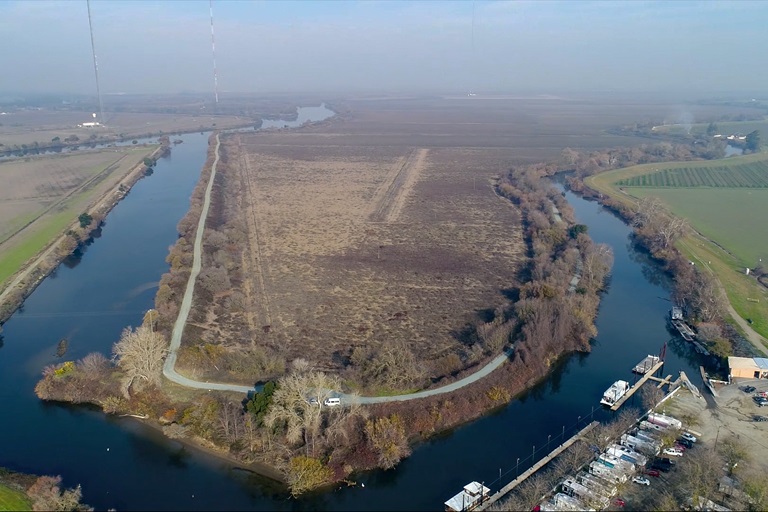McCormack-Williamson Tract Project Aims to Protect People and Wildlife
An aerial view of the southern tip of McCormack-Williamson Tract. DWR/2019
Editor’s note: The following article is part of a continuing series highlighting the California EcoRestore Initiative, which seeks to restore 30,000 acres of habitat in the Sacramento-San Joaquin Delta by 2020. California EcoRestore is an umbrella program that includes habitat restoration efforts implemented and funded by departments under the California Natural Resources Agency including Department of Water Resources, Department of Fish and Wildlife, and Delta Conservancy.
Located just south of the confluence of the Cosumnes and Mokelumne Rivers, the McCormack-Williamson Tract is a north Delta island with a long history of flooding. During the highwater events of 2017, water filled the island after the Cosumnes River overtopped the levee on the northeast bank. McCormack’s southern levees held firm, but had the levees broken, water could have rushed toward surrounding islands, potentially inundating private properties.
The Department of Water Resources (DWR), the Nature Conservancy, a conservation group that owns the site, and local, state, and federal partners acted fast: opening notches in levees on the north and south sides of McCormack to allow water to slowly drain off the island.
Once the flood season ended, DWR and its partners pumped the remaining water off the island, and repaired portions of the levees. Nearby landowners worked closely on the project, adding input as to where officials could open the levees.
“Landowners were happy we were able to move quickly and take action,” said Dawit Zeleke, Director of Conservation with The Nature Conservancy.
Breaking Ground
In 2018, DWR and its partners broke ground on a restoration project nearly a decade in the making. The project incorporates some of the fixes and lessons learned from the breaching event in 2017.
The McCormack-Williamson Tract restoration project, a 1,500 acre site, lowers the levees on the north side of the island to allow the river to overtop into the site. On the south side, DWR will alleviate the surge flows that pose a risk to neighbors by opening small holes in the levee. It’s a near replication of the response to the 2017 overtopping event.
2018 saw the completion of construction of a levee to protect existing infrastructure on the site, as well as progress on habitat restoration plans. For the next phase of the project, DWR will strengthen the interior levees and take steps toward opening the site up to tidal flows.
“The aim (of this project) is to restore natural floodplains and tidal marsh habitats, and also to reduce flood risk in the area,” said Anitra Pawley, McCormack-Williamson Tract project lead at DWR. “These are habitats which are very rare in the Delta and have been lost. We can recreate those habitats in this location.”
“We hope the restoration project will provide a tidal habitat for Delta smelt, and a shallow area for giant garter snakes and migratory birds,” she added.
The project brings together the goals of DWR, the Nature Conservancy and Reclamation District 2110 to restore the Delta island while balancing flood protection for neighboring residents.
McCormack-Williamson Tract is located at a higher elevation relative to most of the Delta. If the same project were attempted at a lower elevation, the land would be constantly inundated, a tidal habitat wouldn’t be possible, and fish and wildlife couldn’t adequately recolonize the area.
“The project is kind of a sweet spot in conservation because it has multiple benefits for people and wildlife,” Zeleke said.
Contact:
Allen Young, Information Officer, Department of Water Resources
916-653-3925 | allen.young@water.ca.gov
